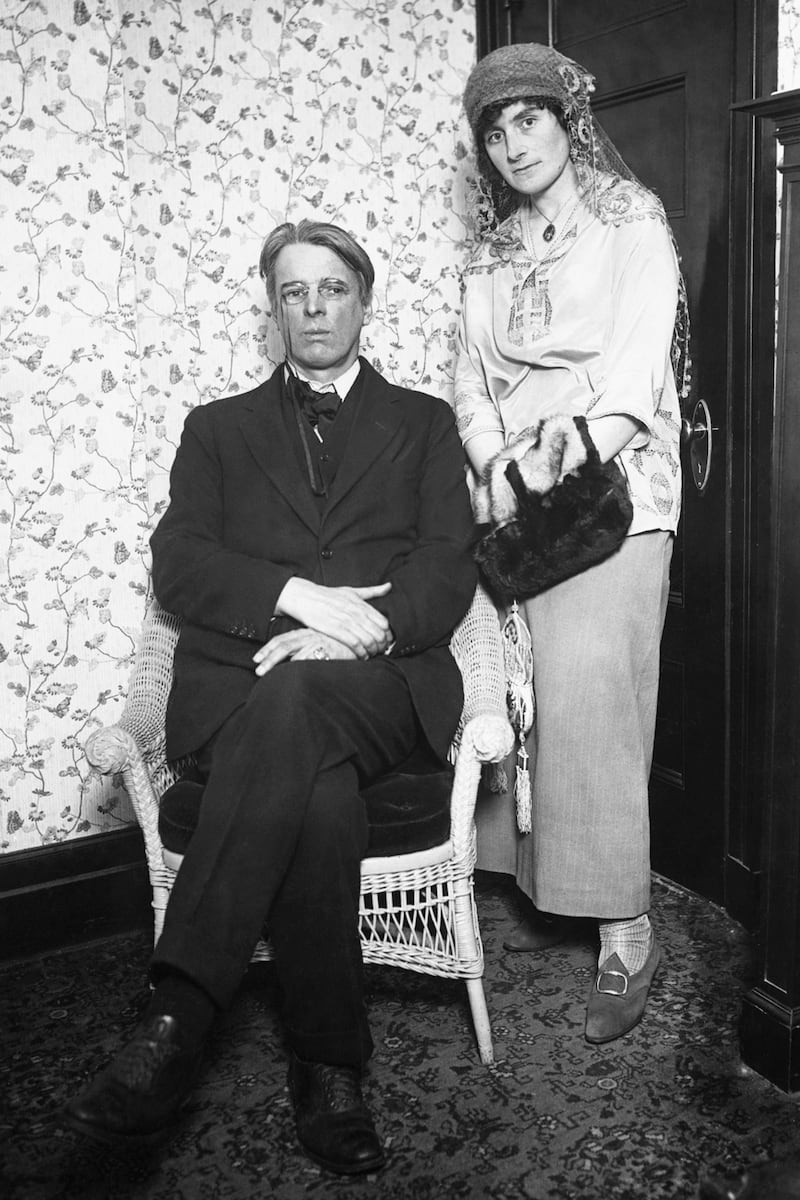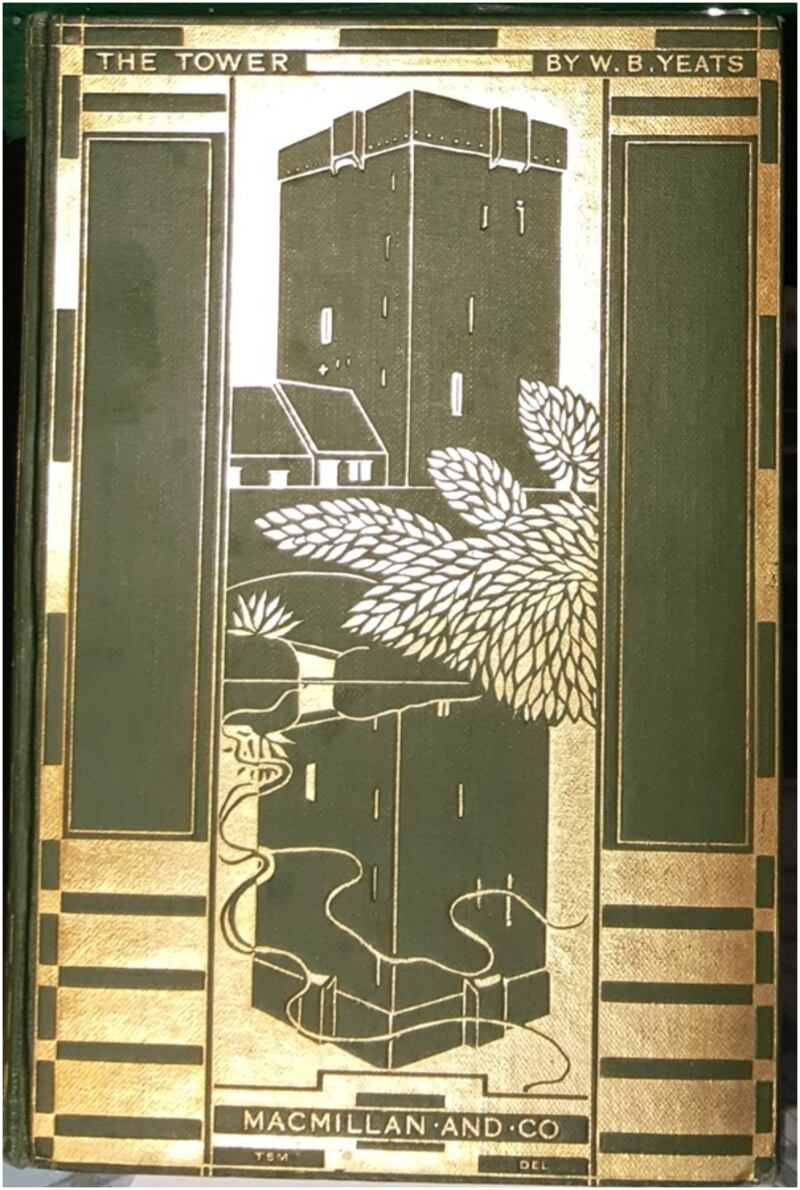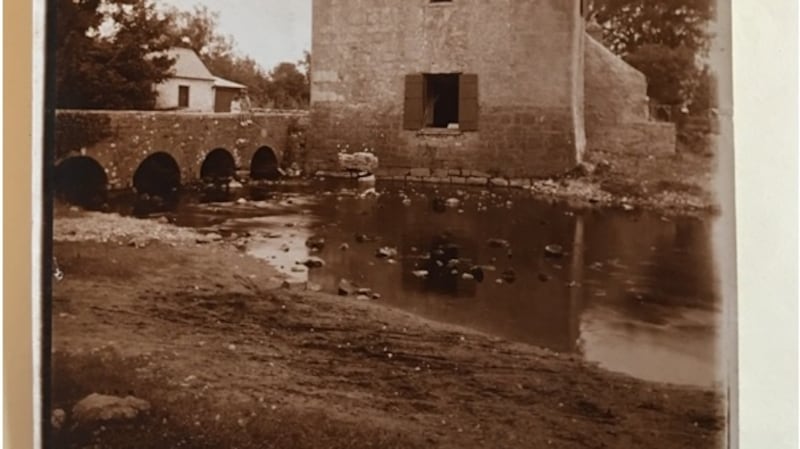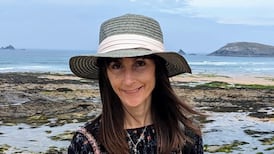When WB Yeats heard in 1909 that his closest friend Augusta Gregory was seriously ill, he wrote poignantly, “Friendship is all the house I have”. The metaphor cuts to the bone. He had grown up peripatetically, his impoverished artist father moving the family from one modest rented accommodation to another. The houses belonging to his mother’s family in Sligo were the only enduring presences in his background; perhaps because of this, the poet had a longing all his life, as his friend Oliver Gogarty said, for a “household of continuance”.
For much of his life, from the time he left home in 1895 until his marriage at the age of 52 in 1917, he lived in a rented apartment in Woburn Buildings in London, near Euston Road (and convenient for the Irish boat train). But during the summers he had an adopted home in the Irish countryside – not in Sligo, but near Gort, Co Galway. This was Lady Gregory’s house, Coole Park.
Coole was Yeats’s “household of continuance” and he loved it with a passion – “more than all other houses”, as he once said. It was substantial rather than grand, a plain Georgian house buried in its fabled woods, and full of contents which expressed its history and that of the Gregory family; as Yeats recalled, “Balzac would have given twenty pages to the stairs”.
But he was a guest there only. The house was in fact the property of Lady Gregory’s son Robert, though she was chatelaine for her lifetime, and Robert and his wife deeply resented Yeats’s constant presence there. As in his friend Ottoline Morrell’s house at Garsington near Oxford, which also inspired his poetry, or (towards the end of his life) Dorothy Wellesley’s beautiful Sussex house Penns in the Rocks, Yeats was a essentially a bird of passage. He loved houses, cared deeply about art and architecture, and was preoccupied by the way a room looked and what went into it – he had been an art student, after all.
The style of his Woburn Buildings flat was remarked upon by many – tall candles in massive candlesticks, William Blake engravings, busts of poets, piles of books everywhere. But throughout his life, he lived in leasehold properties. He only ever owned one house outright: the old tower-house at Ballylee near Gort, usually described as Norman though there is not much record of it before the 16th century.
Yeats had seen it on his visit to Galway in 1896, when his long association with Gregory and Coole began. Built by the de Burgo clan, and at one point owned by the Gregorys, by 1916 it was transferred with other lands to the State, in the form of the Congested Districts Board.
Yeats first saw it when accompanying Lady Gregory on her folklore-collecting missions. As he recorded in 1899: “I have been lately to a little group of houses, not many enough to be called a village, in the barony of Kiltartan in Co Galway, whose name, Ballylee, is known through all the west of Ireland. There is the old square castle, Ballylee, inhabited by a farmer and his wife [actually the retired master of the Loughrea workhouse], and a cottage where their daughter and their son-in-law live, and a little mill with an old miller, and old ash trees throwing green shadows upon a little river and great stepping-stones.
“I went there two or three times last year to talk to the miller about Biddy Early, a wise woman that lived in Clare some years ago, and her saying ‘There is a cure of all evils between the two mill-wheels of Ballylee’, and to find out from him or another whether she meant the moss between the running waters or some other herb. I have been there this summer and I shall be there again before it is autumn, because Mary Hynes, a beautiful woman whose name is still a wonder by the turf fires, died there sixty years ago; for our feet would linger where beauty has lived its life of sorrow to make us understand that it is not of this world.”
The 18th-century poet Antoin Raftery had celebrated Mary Hynes’s beauty in verses which Lady Gregory had translated. So the tower-house carried sacred associations – with poetry, with a legendary beauty who brought sorrow in her wake (Yeats was always on the look-out for a Helen of Troy), and with the folklore and history of this beautiful part of Ireland. And it was a tower. Yeats’s poetic education, heavily featuring Milton, Shelley and Keats, is full of towers, where lonely scholars (or poets) toiled by candlelight, or where tragic princesses were immured. There are other kinds of symbolism too, as Ezra Pound mischievously noted when Yeats eventually bought the tower, describing it as a “phallic symbol on the bogs – Ballyhallus or whatever he calls it with the river on the first floor”.
Though Yeats “long coveted it”, he had very little money, at least until he started giving lecture tours in America, and acquired a Royal Literary Fund pension. In 1916 he began negotiating to buy the tower, which was now roofless and with its floors fallen in, the two attached cottages (one of them in ruins), and a small piece of land across the road. He bought the freehold for £35, and by May 1917 was sharing his ideas for it in excited letters; to his father stressing that it would be made habitable “at no great expense” and would in fact be an economy (just in case the old man thought he had come into funds and started applying for some of them); and telling his friend Olivia Shakespear that the cottages would be rebuilt to give three bedrooms, sitting room, kitchen, bathroom, before he repaired the castle; this would cost £200. He would raise the money by lecturing.
But by late 1917 his position had changed. His love-life went through spectacular somersaults in 1916-17 when he proposed marriage once more to the newly-widowed Maud Gonne, and – after being turned down – to her daughter Iseult, before suddenly marrying the much younger Georgina or “George” Hyde-Lees in October 1917. He would subsequently claim that he restored the tower “for his wife” but the project was conceived and begun well before this sudden step. Moreover, it was her money that enabled the restoration (over several years) to get going.


It was quite an undertaking. There were four rooms, one on each floor of the tower-house, connected by a spiral stone staircase embedded in the huge wall. Each had a window overlooking the river. There was a flat roof on the top. Advised by aesthetic friends, Yeats retained the services of Prof William Scott of the National University’s school of architecture, well known for his ecclesiastical work in a Celtic revival mode, but also for being more or less permanently drunk. Scott designed fireplaces and furniture for the tower, working with local materials and craftspeople; slates and stones were bought from a nearby abandoned mill, though the envisaged roof of “sea-green” Liscannor slates didn’t materialise; given the wild Atlantic storms, a flat cement roof was settled upon instead. (Yeats thought at one point of having a tarred canvas roof, as in Wagner’s first theatre at Bayreuth).
The builder was a local man called Michael Rafferty whom Yeats invariably called Raftery, determined to invoke the poetic associations; furniture was made to Scott’s designs by Patrick Connolly, a gifted craftsman joiner in Gort. Scott’s aesthetic stressed the medieval; he wanted wicker hoods on the great fireplaces, insouciant about the fire risk. Lady Gregory oversaw much of the operations while Yeats was away and was relentlessly nagged by letters from the poet. By July 1918, Yeats could wrote to his friend John Quinn that he had drafted a poem to be inscribed by the front door of the tower

I the poet, William Yeats,
With common sedge and broken slates
And smithy work from Gort forge
Restored this tower for my wife George;
And on my heirs I lay a curse
If they should alter for the worse
From fashion or an empty mind
What Raftery built and Scott designed.
The eventual inscription would have a more elegiac conclusion:
I the poet William Yeats
With old mill boards and sea-green slates
And smithy work from the Gort forge
Restored this tower for my wife George.
And may these characters remain
When all is ruin once again.
Perhaps this scaling-back of the “household of continuance” to a less ambitious conclusion reflects the fact that the building project went on so long and raised so many difficulties. Yeats, George and their baby Anne were able to spend the summer of 1919 there, though they lived mainly in the cottages as the upper rooms of the tower still were unfinished. In July Yeats wrote to his father: “I am writing in the great ground floor of the castle – pleasantest room I have yet seen, a great wide window opening over the river and a round arched door leading to the thatched hall. . . There is a stone floor and a stone-roofed entrance hall with the door to a winding stair to left, and then a larger thatched hall, beyond which is a cottage and kitchen. On the thatched hall imagine a great copper hanging lantern (which is however not there yet but will be, I hope, next week). I am writing at a great trestle table which George keeps covered with wild flowers.”
The upper rooms were slowly conquered in the early 1920s; our main impression of how the tower looked, and its arts-and-crafts aesthetic, come from photographs of the interior taken in 1926 by Thomas Hynes. The Yeatses chose roughly-woven curtains, dyed strong colours such as blue and orange, and furniture of medieval inspiration. They considered installing a stained glass window by Burne-Jones, a wedding-present from Charles Ricketts, but (luckily) didn’t. They were also establishing their Dublin life at 82 Merrion Square; and the Irish Free State, in whose government Yeats was a senator, was coming into existence amid civil war.
The tower was broken into on several occasions, and objects such as mirrors were stolen: one was left upright in a ditch and a terrified local drunk, returning from the pub, thought his reflection was a ghost. The building work proceeded fitfully, and dealing with the alcoholic Scott raised difficulties, compounded when he suddenly died in 1921. Yeats’s Nobel Prize in 1923 eased the financial situation, though it was fairly rapidly dissipated by the demands of his sisters’ Cuala Press and his Abbey Theatre colleague Lennox Robinson’s disastrous advice to invest it in railway shares.
But the excitement Yeats felt at creating his own house from historic materials pulses through his letters.
Though Yeats calls it “the Castle” he was determined to avoid the term as formally applied to the house, because of its associations with “deer-parks and modern Gothic”: choosing “thoor”, an anglicisation of the Irish tur (tower) instead. There are other implications in this letter too. The house is not yet finished – only four years before they would give up going there. And there is a constant threat of floods. This would in fact make the tower and cottages uninhabitable outside the summer. On several occasions the Yeatses had to retreat up the winding stair clutching their possessions, or evacuate to Coole.
Their small children loved the place but they also remembered the sweeping of accumulated mud and worms out of the lower rooms as a ritual of arrival. Sanitation was elementary: one lavatory in one of the cottages, accessible only through the children’s bedroom. Supplies had to be ordered from Gort (although a garage was built to house a Ford car, the vehicle never materialised). George loved the place, and devoted much time to embellishing it, painting the wooden ceilings in vivid colours with symbolic and occult significance, though it was Yeats who decreed that the window-frames be bright red, to Lady Gregory’s disapproval. (George wanted bright blue).
With Yeats’s serious illness in 1927-8, the family moved for some time to Rapallo in Italy, which signalled the end of their summers in Ballylee. In 1930, Lennox Robinson approached George on behalf of a possible tenant (Pamela Travers, author of Mary Poppins, a rather unexpected addition to the Irish literary set in the 1930s). George sent Robinson a characteristically frank outline of its disadvantages. 1928 was the last time Yeats and George were there together (though George and the children occasionally visited). By then the tower had served its purpose.
That purpose was artistic as well as domestic. Living in a tower not only put Yeats in line with poetic heroes such as Shelly’s Prince Athanase, Milton’s Il Penseroso, and Villers de Lisle Adam’s Axel; it also linked him to Irish history, with its successions of invasions and settlements. His 1921 collection Michael Robartes and the Dancer ended with the poem “to be carved on a stone at Thoor Ballylee”, and much of that collection reflects the tower. Most dramatically, A Prayer for my Daughter opens with an invocation of the house where his infant sleeps.
Once more the storm is howling, and half hid
Under this cradle-hood and coverlid
My child sleeps on. There is no obstacle
But Gregory’s wood and one bare hill
Whereby the haystack- and roof-levelling wind,
Bred on the Atlantic, can be stayed;
And for an hour I have walked and prayed
Because of the great gloom that is in my mind.
I have walked and prayed for this young child an hour
And heard the sea-wind scream upon the tower,
And under the arches of the bridge, and scream
In the elms above the flooded stream;
Imagining in excited reverie
That the future years had come,
Dancing to a frenzied drum,
Out of the murderous innocence of the sea.
But his next collection, in 1928, took as its central theme and principle the building of the tower – which supplied the title poem of the book, and the wonderful cover- illustration by Sturge Moore. The title-poem is an interrogation of old age and philosophy, and again the tower-house is sharply evoked; the poet paces on his battlemented roof, staring at the countryside around and remembering the associations, stories and traditions it evokes (including, of course, the legendary beauty Mary Hynes).
The poem also resurrects the tower’s previous inhabitants (“Rough men-at-arms, cross-gartered to the knees”), and interrogates Yeats’s own memories of his life. The final section, cast in the form of a testament, invokes jackdaws building nests in the loophole windows of the tower.
Above all, the great sequence Meditations in Time of Civil War, started at Coole in early June 1922 and continued at Ballylee, stands as the tower’s monument. It begins with the marvellous stanzas of Ancestral Houses, where he takes the theme of houses like Garsington and Coole to suggest ominously – that violence and bitterness are an inescapable part of building a civilisation – which will decline as those qualities mutate into gentleness. The next section of the sequence, called simply My House, is an utterly concrete evocation of his own tower, subtly following through that theme of bitterness and violence.
The sequence continues to interrogate themes of descent, inheritance, the bearing of children, and the possible futures of “this laborious stair and this stark tower”, which he has chosen for an old neighbour’s friendship and decked and altered “for a girl’s love”:
And know whatever flourish and decline
These stones remain their monument and mine.
The sequence records his life in the tower as civil war rumbles all round him. He recalled this in his speech accepting the Nobel Prize: “I was in my Galway house during the first months of the civil war, the railway bridges blown up and the roads blocked with stones and trees. For the first week there were no newspapers, no reliable news, we did not know who had won nor who had lost, and even after news-papers came, one never knew what was happening on the other side of the hill or of the line of trees. Ford cars passed the house from time to time with coffins standing upon and between the seats, and sometimes at night we heard an explosion, and once by day saw the smoke made by the burning of a great neighbouring house. Men must have lived so through many tumultuous centuries. One felt an overmastering desire not to grow unhappy or embittered, not to lose all sense of the beauty of nature. A stare (our West of Ireland name for a starling) had built in a hole beside my window and I made these verses out of the feeling of the moment.”
The sequence ends as it began, with a complex meditation on the inheritance of violence, the infection of bitterness, the visions of the clanging wings and terrible vengeance of the Furies, as seen from – yet again – the broken stone battlements of his roof.

The tower also dominates Yeats’s next collection in 1933, as indicated by the title, The Winding Stair. In Blood and the Moon, written in the wake of Kevin O’Higgins’s assassination, Yeats issues a celebrated manifesto:
I declare this tower is my symbol; I declare
This winding, gyring, spiring treadmill of a stair is my ancestral stair;
That Goldsmith and the Dean, Berkeley and Burke have travelled there.
Thus his tower enabled him to link his own life and achievements with those 18th-century thinkers whom he was adopting more and more closely. This volume also includes his beautiful elegy for Augusta Gregory, written before her death in 1932, which links their two houses by the image of the underground river that connects Ballylee to Coole.
But by the time The Winding Stair was published, the Yeatses had given up the tower; the poet’s uncertain health, the death of Augusta Gregory in 1932, the impracticality of the house, made it inevitable. It had served its purpose, supplying a powerful governing focus not only for the new married life begun in 1917 (which was also a new journey into spiritual and occult discoveries); it also inspired some of Yeats’s greatest poems, and supplied the organising principle whereby he explored his own relation to the violent past and the unknown future. It is, therefore, a literary monument of the first importance.


When the American poet Robinson Jeffers visited the shuttered-up Thoor Ballylee in 1929 (which inspired him to build his own tower on the Californian coast), it was already effectively abandoned. Throughout the 1930s it gradually began to decay back towards its original state. The stone with his dedicatory poem was erected there by the board of the Abbey Theatre in his memory, nine years after his death, in 1948. Four years later the Yeats scholar Virginia Moore visited it and found it inhabited by cattle and crows; furniture, rose garden and bridge were all gone. (When she reported this to George Yeats, she received the crisp reply “That’s the way we found it; it’s come full cycle.”)
Nine years later, in 1961, Mary Hanley founded the Kiltartan Society, to develop interest in the extraordinary literary history of the area, and to restore Ballylee, which was impressively achieved with local enthusiasm and the help of the tourist board, Bord Fáilte. The Yeats family made over the property to a Trust to ensure its maintenance and the building was declared a National Monument. The roofs were repaired, original furniture was hunted down or reproduced and the interiors restored as closely as possible. George was able to advise on this, as she lived on until 1968.
The tower was opened in 1965; visitors over the next 30 years could absorb its atmosphere, and climb the winding stair to the flat roof where Yeats stared out from his battlements (and on one occasion, sat reading an early copy of Ulysses until driven inside by horseflies). Those visitors included other poets, such as Sylvia Plath and Ted Hughes, brought there by Richard Murphy in 1962. But even the future of a National Monument is not secure. The tower continues to suffer the vagaries of weather, and uncertain funding; by 2009 it was badly in need of further restoration, and was inundated during the freak floods that winter. Given the state of national finances, there were few resources to repair it; but the Thoor Ballylee Society and the generosity of the American Yeats scholar Joseph Hassett enabled a reopening on Yeats’s 150th anniversary in June 2015. Cruelly, during the ensuing winter disastrous floods invaded the Tower once more, but it has recently re-opened again, as atmospheric as ever. [And since this book was written, flooded again in March 2020].
Buildings carry a certain historical baggage in Ireland, though finally the great architectural heritage of the 18th and 19th centuries has been accepted as the national treasure it is, rather than merely the evidence of colonial domination. Impressive work has been done in adapting military institutions designed as barracks or prisons for new purposes. Thoor Ballylee, as Yeats wrote, itself possesses a history reflecting violence and domination – but it was re-adapted, in his custodianship and through his poetry, into what Seamus Heaney called it, “a sacramental site”. Poetic prescience enabled Yeats to predict the tower’s future vicissitudes, as well as to invoke its chequered past: but it has avoided the ruination which he accurately prophesied for Coole.
For all the comedy and inconveniences attendant upon his attempts to live in a symbol, his instinct that Ballylee was essential to him was triumphantly vindicated. Those stones remain his monument in more ways than one.
This is an extract from Lives of Houses, edited by Hermione Lee and Kate Kennedy and published by Princeton University press, priced £20










